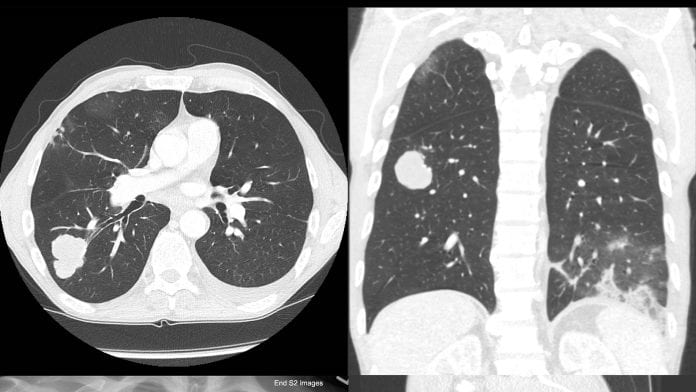
Researchers at MD Anderson, USA, discovered some forms of aggressive cancer may respond to a combination of immunotherapy and DNA damage repair inhibitors.
According to The University of Texas MD Anderson Cancer Center, a combination of immune checkpoint blockade and targeted therapies that block normal DNA damage repair (DDR) achieved significant tumour regression in mouse models of the aggressive cancer that is small cell lung cancer (SCLC), suggesting a promising new approach for treating patients with this debilitating disease.
Battling aggressive cancer
Published in Cancer Discovery, the preclinical research, suggests that the PARP inhibitor olaparib and other DDR inhibitors induce a rapid immune response and sensitise SCLC cells to immunotherapy, to which they were previously resistant.
Small cell lung cancer, one of the most aggressive types of cancer, makes up about 15% of all lung cancers diagnosed in the U.S., representing about 30,000 patients each year.
Standard treatment for advanced SCLC is chemotherapy, but recurrence is common and the average survival is only about 12 months. For about 30 years, there were no changes to this approach, but recently the use of immunotherapy in combination with chemotherapy has become a new standard. However, the benefits are minimal for patients.
Lauren Averett Byers, M.D., associate professor of Thoracic/Head & Neck Medical Oncology and corresponding author on the study, explains: “While the use of immunotherapy has revolutionised the way we treat lung cancer, we find that small cell lung cancers can escape the immune system very effectively, so we see a much lower response rate.”
“However, we want to do a lot better for our patients, and we think there’s a lot of room for further improvement.”
Linking immunotherapy to inhibitors
Previously, Byers discovered that DDR pathways were highly active in SCLC and blocking these pathways with drugs, such as PARP and CHK1 inhibitors, was effective in treating SCLC in the lab.
Moreover, cancers with extensive amounts of DNA damage have been shown to respond better to immunotherapy.
“Therefore, we predicted that if we combined PARP inhibitors or other drugs that cause DNA damage with immune therapies, we might see a much greater response to the immune therapy,” said Byers.
“We found that if we added either PARP or CHK1 inhibitors to immunotherapy, we saw a dramatic shrinkage of tumours. In fact, in some cases, the tumours disappeared completely.”
Uncovering ways of killing aggressive cancer
Combining the CHK1 inhibitor, prexasertib, or the PARP inhibitor, olaparib, together with an immune checkpoint inhibitor against PD-L1 resulted in significant tumour regression in SCLC mouse models, whereas immunotherapy alone had no effect.
The combination of PARP inhibitor and immunotherapy resulted in complete regression in all treated mice in as little as one week, leaving no tumours available for further analysis.
The CHK1 combination treatment led to complete regression in 60% of treated mice.
The researchers discovered that DDR inhibitors activated an immune response in the mice, leading to an increase in cancer-killing immune cells in the tumors. This process was controlled by the STING pathway, which normally works to detect signals of a viral or bacterial infection. In this case, the STING pathway responded to DNA damage to activate the immune system, thus making SCLC cells susceptible to immunotherapy treatment.
Time to launch further clinical trials
“I think the results from this study are really compelling because of the dramatic activity that we saw with the combination of adding a targeted therapy to immune therapy,” said Byers.
“I think our findings can be rapidly translated into the clinic for our patients and also to other cancer types.”
Clinical trials testing PARP inhibitors or immunotherapies for patients with SCLC are ongoing.
Hoping to launch clinical trials to investigate the combination approach later this year, Byers and colleagues expect this may also be effective in other cancer types defined by increased DNA damage, such as BRCA-mutant breast and ovarian cancers.






















